-
oa Is the Hyperdensity Areas of the CT Blend Sign Associated with the Fresh Bleeding in Intracerebral Hemorrhage?
- Source: Current Medical Imaging, Volume 20, Issue 1, Jan 2024, e15734056310498
-
- 17 Apr 2024
- 16 Sep 2024
- 01 Jan 2024
Abstract
Controversies still exist regarding the mechanism formation of the blend sign, defined as hypodensity and hyperdensity regions, in Intracerebral Hemorrhage (ICH), and which region associated with bleeding remains unknown. Spot sign is an independent predictor of hematoma expansion (HE) and indicates persistent bleeding focus in the hematoma. Here, we sought to establish the relationship between the spot sign and the blend sign to gain insights into the formation of the blend sign.
Patients were categorized based on the spot sign location within the blend sign in patients with ICH from 2018 to 2023. subjects with a spot sign in the hypodensity region of the blend sign (hypo-spot sign group); subjects with a spot sign in the hyperdensity region of the blend sign (hyper-spot sign group). Subsequently, patients were stratified into two groups based on the presence or absence of HE. Also, we analyzed the relationship between the spot sign and the blend sign, as well as the association between the blend sign and HE.
A total of 205 patients were included, including 190 patients (92.7%) who had the spot sign in the hyper-spot sign and 15 patients (7.3%) who had the spot sign in the hypo-spot sign. HE was observed in 60 patients (29.3%), 59 (98.3%) of whom had the spot sign detected in the hyper-spot sign, while only one (1.7%) had the spot sign in the hypo-spot sign. Univariate logistic regression analysis revealed that the hyper-spot sign group (6.305, 1.810–49.072; P < 0.05) was an independent predictor of HE.
The hyperdensity area of the blend sign may represent fresh bleeding in ICH rather than the hypodensity area.
ClinicalTrials.gov, NCT05548530. Registered on September 21, 2022, Prognostic Analysis of Different Treatment Options for Cerebral Hemorrhage-Full Text View - ClinicalTrials.gov “retrospectively registered.”


